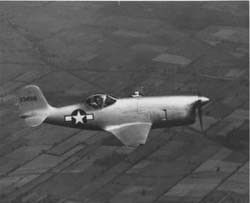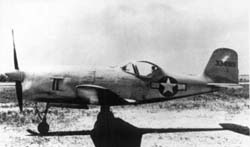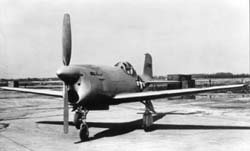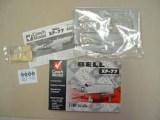XP-77
After the attack on Pearl Harbor by Japanese planes, the Americans discovered in a painful way that the Japanese armed forces had a fighter that seemed to be far superior to all what the U.S. forces could bring in the air. This fighter was the Mitsubishi Navy-0 or Zero which seemed to have an almost mythical maneuverability and elusively. When a relatively undamaged force-landed Zero was captured by the Americans, the first reaction of the general staff of the Army Air Force was that the Zero fighter was nothing more than ‘ a sports plane with a 1000 hp engine’ .
 On 30 October 2941 General Hap Arnold sent a proposal to the aircraft manufacturers to develop a similar fighter based on the concept of the Zero with the code designation ‘Tri-4’ . This Tri-4 was to be made of less strategic materials; mainly of wood. Further requirements were an extreme maneuverability, minimal weight, easy field maintenance and easy to fly. In fact, the Americans already had some experiences with this type of plane, since in the pre-war air races a number of racing planes had been built with exactly these characteristics.
On 30 October 2941 General Hap Arnold sent a proposal to the aircraft manufacturers to develop a similar fighter based on the concept of the Zero with the code designation ‘Tri-4’ . This Tri-4 was to be made of less strategic materials; mainly of wood. Further requirements were an extreme maneuverability, minimal weight, easy field maintenance and easy to fly. In fact, the Americans already had some experiences with this type of plane, since in the pre-war air races a number of racing planes had been built with exactly these characteristics.
Chief-engineer John Woods of Bell Aircraft Company and his team designed under this Tri-4 proposal a small fighter that received the fighter designation XP-77. Wood’s design bore a striking resemblance to the last generation of pylon racers with its backwards placed cockpit and short tapered wings. Further it was fitted with a fully retractable undercarriage with a nose wheel. The XP-77 was mainly constructed of wood except for the front fuselage section where the engine was covered by light-alloy panels. The selected engine was the air cooled Ranger XV-770. Fitted with a special Planiol compressor from France, Bell’s mini-fighter would have been capable of reaching a top speed of 660 km/h at 8230 m altitude. However, there was one problem: France was meanwhile partly occupied by the German forces and the ‘free’ Vichy government prevented the supply of these special compressors. Without it, the performance of the Ranger engine quickly declined at higher altitudes. For this reason, an earlier order for 25 P-77 production models was brought back to six only. By the time there was a satisfying solution for the compressor problem, there was no more need for the lightweight interceptor. Because captured Zero’s had been amply tested, existing U.S. fighters were found to be fully capable to act effectively against the Zero by changing their tactics!

 Meanwhile, it was already 1944 and by that time the Americans did not have to worry about the availability of strategic materials like aluminum. In spite of this, Bell was ordered to complete and supply two XP-77 prototypes. The were assigned the serial numbers 43-34915 and 43-34916.
Meanwhile, it was already 1944 and by that time the Americans did not have to worry about the availability of strategic materials like aluminum. In spite of this, Bell was ordered to complete and supply two XP-77 prototypes. The were assigned the serial numbers 43-34915 and 43-34916.
The first flight of the XP-77 took place on 1 April 1944. During next test flights it was discovered that at certain engine rpm’s the plane was very unpleasant to fly due to the absence of vibration dampers in the engine mountings. Eventually the operational suitability program and performance testing were terminated in December 1944 after the second machine crashed on 2 October 1944. With the first prototype, very few flights were made until just after the war.
 Technical details
Technical details
Power plant: Ranger XV-770-7 air cooled 12-cilinder inverted-V engine of 520 hp
wingspan 8.38 m
length 6.98 m
height 2.5 m
wing area 9.29 m2
empty weight 1295 kg
loaded weight 1665 kg of the 1st prototype; 1625 kg for the 2nd
maximum speed 531 km/h at 1220 m altitude
service ceiling 9175 m
range 885 km at 441 km/h
Armament two 12.7 mm machine guns with 200 rounds each for the P-77 production version. The two prototypes were unarmed.
Accommodation pilot only
 Czech Model has released a 1/48 scale model kit of the XP-77. It is a limited-run injection molded kit with a vacuform canopy and additional resin parts included. One of these parts is the engine; it also acts as contra-weight to prevent the built model sitting on its tail! The kit is fitted with clear English building instructions and decals for both prototypes. If built with care, it will turn into a very nice little model.
Czech Model has released a 1/48 scale model kit of the XP-77. It is a limited-run injection molded kit with a vacuform canopy and additional resin parts included. One of these parts is the engine; it also acts as contra-weight to prevent the built model sitting on its tail! The kit is fitted with clear English building instructions and decals for both prototypes. If built with care, it will turn into a very nice little model.
In their 2002 catalogue, the U.S. based Collect-Aire also presented a kit in the same scale. This is complete made of resin parts and is up to the usual high standards of this company. However, also the price is quite high. Although the Czech product is described as an inaccurate ‘ cheap Eastern European knock-off’ in the Collect-Aire catalogue, this criticism is not totally justified!
Nico Braas
Photos- Nico Braas Color profile- Srecko Bradic
References: -William Green, War planes of the second world war-Volume four, Macdonald, London 1961
-Bill Gunston, Prototype Pursuits-part 9, Aeroplane Monthly, April 1980
Remarks:
-Tucker Aviation Co. at Detroit-Michigan also proposed a small light-weight fighter. It received the fighter designation XP-57. The XP-57 was planned with a 720 hp in-line Miller L-510-1 eight cylinder liquid-cooled engine fitted behind the cockpit. Just like the Bell P-39, the propeller on the nose was driven by an extension shaft. The XP-57 was never built.
-An earlier attempt for a light-weight fighter resulted in the Curtiss CW-21 Demon, powered by a 850 hp Wright Cyclone radial engine. Rejected by U.S. forces, it was ordered by the Dutch for operational use in the Dutch East Indies. During the war they were used against Japanese Zeros. They were completely outclassed and most of them were destroyed!
-On some photographs, 43-34915 is seen with post-war U.S.A.F. markings and the logo ‘Bell XP-77’ on its nose and colored stripes on the rear fuselage and rudder. Most likely, this scheme was used for exhibition purposes only and also most likely it never flew with these markings.
-Final disposal of the remaining XP-77 is unknown, but the plane has definitely not survived!





